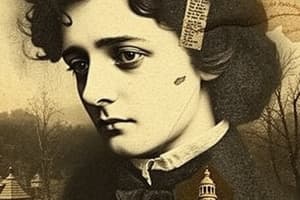Podcast
Questions and Answers
What is the primary emotion described in the text?
What is the primary emotion described in the text?
- Joy
- Excitement
- Terror (correct)
- Sadness
What is the significance of the bells in the text?
What is the significance of the bells in the text?
- To convey terror and despair (correct)
- To bring joy to the people
- To signal the end of a celebration
- To create a sense of peace
What do the bells symbolize in the text?
What do the bells symbolize in the text?
- Harmony
- Celebration
- Peace
- Terror and menace (correct)
How does the text describe the sound of the bells?
How does the text describe the sound of the bells?
What feeling do the people who toll the bells experience?
What feeling do the people who toll the bells experience?
What type of figurative language is predominantly used in the poem 'The Bells'?
What type of figurative language is predominantly used in the poem 'The Bells'?
What is the main effect created by the repetition of 'bells, bells, bells' in the poem?
What is the main effect created by the repetition of 'bells, bells, bells' in the poem?
Which word best describes the tone of the third stanza in 'The Bells'?
Which word best describes the tone of the third stanza in 'The Bells'?
In the poem, what does the phrase 'keeping time' refer to?
In the poem, what does the phrase 'keeping time' refer to?
What aspect of the stars is highlighted in the first stanza of 'The Bells'?
What aspect of the stars is highlighted in the first stanza of 'The Bells'?
Which literary device is showcased through the line 'With a crystalline delight' in 'The Bells'?
Which literary device is showcased through the line 'With a crystalline delight' in 'The Bells'?
Flashcards are hidden until you start studying
Study Notes
Imagery and Sound
- The poem "The Bells" by Edgar Allan Poe uses vivid imagery and onomatopoeia to describe the sounds of bells and their effects on the human psyche.
- The sounds of the bells evoke different emotions and reactions in people, ranging from joy and happiness to fear and terror.
Section I: Sledge Bells
- The poem starts with a description of sledge bells, which are "Silver bells" that "foretell" a world of merriment.
- The bells "tinkle, tinkle, tinkle" in the icy air of night, creating a sense of delight and wonder.
Section II: Wedding Bells
- The second section describes "Golden bells" that "foretell" a world of happiness and harmony.
- The bells "ring out their delight" and produce a "liquid ditty" that floats through the air, evoking a sense of joy and celebration.
Section III: Alarum Bells
- The third section describes "Brazen bells" that "tell a tale of terror" and evoke a sense of fear and alarm.
- The bells "scream out their affright" in the startled ear of night, creating a sense of anxiety and distress.
Section IV: Iron Bells
- The final section describes "Iron bells" that evoke a sense of solemnity and menace.
- The bells toll monotonously, producing a "melancholy menace" that makes people shiver with affright.
Figurative Language
- Poe uses figurative language throughout the poem, including metaphor (e.g., "the bells...tell a tale of terror"), personification (e.g., "the bells...shiver with affright"), and onomatopoeia (e.g., "tinkle, tinkle, tinkle").
- The use of alliteration and assonance adds to the musical quality of the poem, mirroring the sounds of the bells.
Themes
- The poem explores the emotional effects of sound on the human psyche, highlighting the power of bells to evoke different emotions and reactions.
- The poem also touches on themes of joy, happiness, fear, and terror, demonstrating the range of human emotions.
Studying That Suits You
Use AI to generate personalized quizzes and flashcards to suit your learning preferences.




